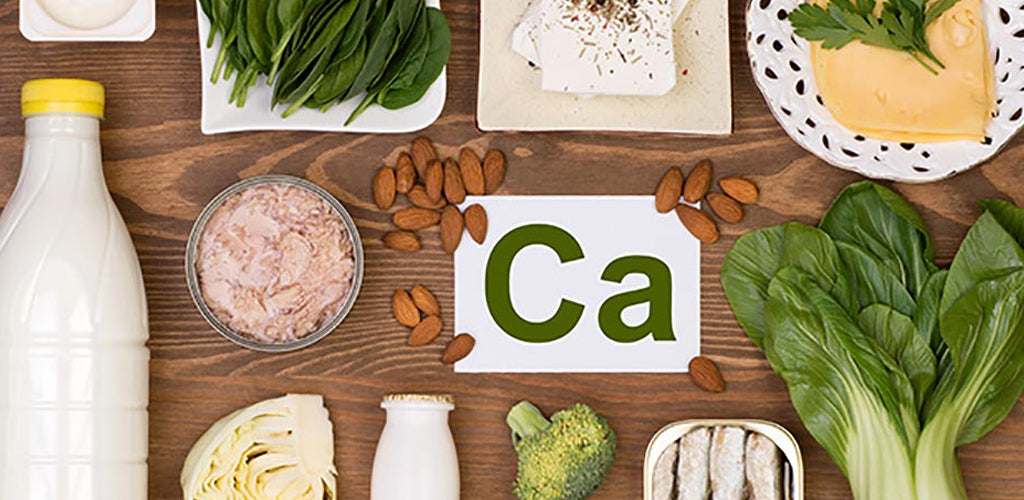Benefits of Calcium and Vitamin D

Calcium
Calcium is a mineral that helps you build and maintain strong bones and teeth. It is also important for our muscles to contract, to keep a normal heartbeat, and to conduct nerve signals to and from the brain. A diet lacking calcium can cause osteoporosis later in life, which can lead to fragile bones and bone fractures, all of which will halt your training and participation in events and competitions.
The level of calcium in the blood is tightly regulated by other hormones in the body. When blood calcium goes down, the body responds by releasing calcium from bone to regain a normal level, which is what causes fragile bones.
Calcium & Exercise
Like many electrolytes, calcium is excreted in sweat. Therefore, individuals exercising in hot and humid conditions or have high sweat rates have increased calcium needs.
It has also been shown that calcium intakes have been inversely related to body weight. This means that the more calcium you consume, the less you weigh (to a certain extent as there are many other, and more important factors, related to weight!). This can be especially interesting for sports relying on weight categories, like boxing, mixed martial arts, and weightlifting. However, the changes seen in weight are only related to calcium ingested through food as calcium supplement intake does not show the same effect.
Factors Affecting Calcium Absorption
Depending on the foods consumed with calcium-rich foods, its absorption can be altered. For example, a diet high in protein and sodium (salt) can increase calcium excretion, especially in post-menopausal women. Fiber and coffee intake also result in calcium loss. This is important to take into consideration for athletes, as protein and sodium requirements are often higher, and coffee/caffeine can be used as a sports supplement to improve performance. However, rather than increasing calcium intake, try to space out your consumption of calcium-rich foods and coffee and foods rich in protein, salt, and fiber by at least one hour.
On the other hand, vitamin D, lactose (sugar found in dairy products), glucose, and a healthy gut all enhance calcium absorption.
Sources of Calcium
To ensure you meet your calcium requirements of 1000 mg/day (1200 mg for men and women over the age of 71 years old) include at least 2 of the following per day:
|
Milk and milk alternatives |
250 ml (1 cup) milk, buttermilk, goat’s milk fortified with calcium, fortified soy or rice beverage, dry powdered milk, and kefir. |
|
Dark leafy green vegetables |
125 ml (1/2 cup) collards, spinach, turnip greens, and kale |
|
Beverages |
125 ml (1/2 cup) orange juice fortified with calcium |
|
Cheese and yogurt |
50 g (1 ½ oz) low-fat cheese, 175g (3/4 cup) plain, fruit-flavored, or soy yogurt. |
|
Fish |
150 g (3/4 cup) tofu prepared with calcium sulfate (read the label!) |
|
Meat alternatives |
175 ml (3/4 cup) beans, 30 ml (2 tbsp) tahini/sesame seed butter, 60ml (1/4 cup) almonds |
Tips to Increase Your Calcium Intake:
- Have a smoothie for breakfast. Just mix low-fat milk and your favorite fruits in a blender.
- Replace the meat in some meals with tofu or white beans.
- Grab a container of plain regular or Greek yogurt as a snack. Add some fresh or dried fruits, nuts and a drizzle of honey!
- Add 1 ½ ounce of low-fat cheese to your serving of pasta.
- Serve your chicken with a milk-based béchamel sauce. In a small saucepan, melt 2 tbsp butter. Add 2 tbsp flour and stir until they are well combined. Pour in 1 cup milk, stirring constantly as it thickens.
Vitamin D
Vitamin D is considered both a hormone and a vitamin. It has an important role in maintaining normal levels of blood calcium as well as regulating bone remodeling. A vitamin D deficiency increases the risk of autoimmune diseases, such as insulin-dependent diabetes mellitus (IDDM), multiple sclerosis, inflammatory bowel disease, systemic lupus erythematosus, and rheumatoid arthritis. Low levels also cause muscle dysfunction and inflammation.
Vitamin D & Exercise
Low levels of vitamin D in the blood are associated with decreased performance over time. Plus, in animal studies, rats who were deficient in vitamin D due to lack of intake and were then administered vitamin D to showed improvements in muscle mass and function. Although we don’t have many human studies, this shows promising effects for athletes who start their season or competition with a low vitamin D status.
As we have seen with calcium, low levels of vitamin D are also associated with decreased bone density and increased risk fracture, which can temporarily pause an athlete’s season.
Sources Of Vitamin D
Vitamin D can actually be obtained from sunlight. During the summer months in Canada, exposure to 15 minutes of sunlight per day in light-skinned individuals and 30 minutes in dark-skinned individuals will result in sufficient of vitamin D. For the rest of the year, a vitamin D supplement may be required as there are only a few food sources of Vitamin D.
Food sources of vitamin D: fortified foods such as margarine and orange juice, milk, eggs, and oily fish like salmon, snapper, and mackerel.
Bottom Line
Both calcium and vitamin D work together to keep our bones strong and aid in muscle function. A deficiency of either nutrient can have negative effects on your health and performance. Luckily, it is easy to reach the recommended intake with foods mentioned above!
Note: The information included is based on the best available evidence at the time and may not be applicable for all athletes. Please consult your local dietitian to get personalized advice.
Sources:
Harrington, M., Bennett, T., Jakobsen, J., Ovesen, L., Brot, C., Flynn, A., & Cashman, K. D. (2004). The effect of a high-protein, high-sodium diet on calcium and bone metabolism in postmenopausal women and its interaction with vitamin D receptor genotype. BJN British Journal of Nutrition, 91(01), 41. doi:10.1079/bjn20031016
Melanson, E. L., Sharp, T. A., Schneider, J., Donahoo, W. T., Grunwald, G. K., & Hill, J. O. (2003). Relation between calcium intake and fat oxidation in adult humans. Int J Obes Relat Metab Disord International Journal of Obesity, 27(2), 196-203. doi:10.1038/sj.ijo.802202
Position of the American Dietetic Association, Dietitians of Canada, and the American College of Sports Medicine: Nutrition and Athletic Performance. (2016).
Rosenbloom, C. (2012). Sports nutrition a practice manual for professionals. (5th ed.). Chicago, Ill.: Academy of Nutrition and Dietetics.
Shulman, L. (2008). Vitamin D Status Predicts Physical Performance and Its Decline in Older Persons. Yearbook of Obstetrics, Gynecology and Women's Health, 2008, 11-12. doi:10.1016/s1090-798x(08)79128-8
Join Source Nation to get the latest news on product launches, Source Exclusive product lines, tips and tricks for parents and players, and more!



